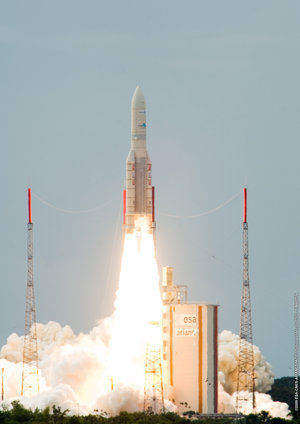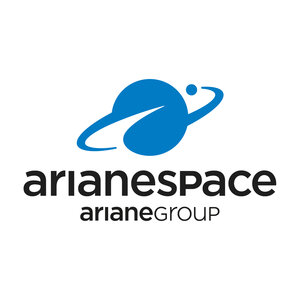Ariane 5 – Dual launch of telecommunications satellites
Early this morning, an Ariane 5 ECA launcher lifted off from Europe’s Spaceport in French Guiana on its mission to place two telecommunications satellites,
Lift-off of flight V190 took place at 00:09 CEST/Paris (22:09 UTC/GMT [21 August];
JCSat-12 will operate in the Ku- and
Arianespace and Europe’s Spaceport are planning seven Ariane launches during 2009, maintaining the heavy-lift vehicle’s flight rate. The ability to sustain high launch rates has already been demonstrated – during the 12-month period from August 2007 to August 2008, there were nine launches (V177 to V185, inclusive).
Flight timeline
The Ariane 5’s cryogenic, liquid fuelled main engine was ignited first. Seven seconds later, the solid fuel rocket boosters were also fired, and a fraction of a second after that, the launch vehicle lifted off.
The solid boosters were jettisoned 2 min: 20 sec after main engine ignition, and the fairing protecting the payload during the climb through Earth’s atmosphere was discarded at 3 min: 28 sec. The launcher’s main engine was shut down at 8 min: 52 sec; nine seconds later the main cryogenic stage separated from the upper stage and its payload.
Four seconds after main stage separation, the engine of the launcher’s cryogenic upper stage was ignited to continue the journey. The upper stage engine was shut down at 24 min: 35 sec into the flight, at which point the launch vehicle was travelling at 9458 metres per second (just over
At 26 min: 44 sec after main engine ignition,
Ariane 5 ECA
Ariane 5 ECA is the latest version of the Ariane 5 launcher. It is designed to place payloads weighing up to 9.6 tonnes into geostationary transfer orbit. With its increased capacity, Ariane 5 ECA can handle dual launches of very large satellites.















 Germany
Germany
 Austria
Austria
 Belgium
Belgium
 Denmark
Denmark
 Spain
Spain
 Estonia
Estonia
 Finland
Finland
 France
France
 Greece
Greece
 Hungary
Hungary
 Ireland
Ireland
 Italy
Italy
 Luxembourg
Luxembourg
 Norway
Norway
 The Netherlands
The Netherlands
 Poland
Poland
 Portugal
Portugal
 Czechia
Czechia
 Romania
Romania
 United Kingdom
United Kingdom
 Slovenia
Slovenia
 Sweden
Sweden
 Switzerland
Switzerland





































